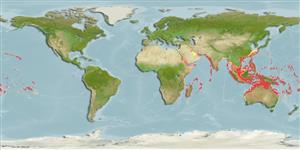>
Holocentriformes (Squirrelfishes, soldierfishes) >
Holocentridae (Squirrelfishes, soldierfishes) > Holocentrinae
Etymology: Sargocentron: Greek, sargos = sargus + Greek, kentron = sting (Ref. 45335).
More on author: Forsskål.
Environment: milieu / climate zone / depth range / distribution range
Ökologie
seewasser riff-verbunden; tiefenbereich 0 - 122 m (Ref. 9710). Tropical; 31°N - 38°S, 30°E - 124°W
Indo-Pacific: Red Sea and East Africa (Ref. 4201) to the Hawaiian and Ducie islands, north to southern Japan, south to Australia; throughout Micronesia.
Size / Gewicht / Alter
Maturity: Lm ? range ? - ? cm
Max length : 51.0 cm FL Männchen/unbestimmt; (Ref. 40637); common length : 35.0 cm TL Männchen/unbestimmt; (Ref. 5450); max. veröff. Gewicht: 2.6 kg (Ref. 40637); max. veröff. Alter: 7 Jahre (Ref. 126389)
Rückenflossenstacheln (insgesamt) : 11; Rückenflossenweichstrahlen (insgesamt) : 14 - 16; Afterflossenstacheln: 4; Afterflossenweichstrahlen: 9 - 10. Head and body red, scale edges silvery white; spinous dorsal crimson in color; other fins orange-yellow; vertically oblong crimson spot on preopercle behind eye (Ref. 4201). Five oblique scale rows on cheek; body depth 2.4-2.6 in SL; head length (HL) 2.55-2.85 in SL; lower jaw when closed slightly to moderately projecting; snout length 3.0-3.8 in HL larger than orbit diameter in adults; interorbital width 6.3-8.7 in HL; maxilla extending posteriorly to a vertical at front edge of the orbit; anterior end of nasal bone often with 2 close-set, short spines; medioposterior margin of nasal bone spineless; large nasal fossa spineless on margin; slight ridge of upper edge of suborbital bones weakly serrate; 2 subequal opercular spines; long preopercular spine, usually greater than orbit diameter in specimens at least 20 cm SL; 3rd or 4th dorsal spine longest, 1.7-2.3 in HL; 3rd anal spine 1.7-2.3 in HL (Ref. 27370).
A solitary species that inhabits a variety of reef zones from reef flats to lagoon and seaward reefs to a depth of at least 122 m and is fairly common in areas not subjected to heavy spear fishing. Found under ledges during the day (Ref. 9710). Benthopelagic (Ref. 58302). Largest species of squirrelfish and the highest-bodied Sargocentron (Ref. 37816). Juvenile inhabits shallow protected reefs. A nocturnal species that feeds on crabs, shrimps and small fishes. Spine of preopercle venomous. Largest squirrelfish (Ref. 48635). Minimum depth reported taken from Ref. 128797.
Life cycle and mating behavior
Maturities | Fortpflanzung | Spawnings | Egg(s) | Fecundities | Larven
Randall, J.E., 1998. Revision of the Indo-Pacific squirrelfishes (Beryciformes: Holocentridae: Holocentrinae) of the genus Sargocentron, with descriptions of four new species. Indo-Pac. Fish. (27):105 p. (Ref. 27370)
IUCN Rote Liste Status (Ref. 130435)
Bedrohung für Menschen
Reports of ciguatera poisoning (Ref. 2334)
Nutzung durch Menschen
Fischereien: weniger kommerziell; Aquarium: Öffentliche Aquarien
Tools
Zusatzinformationen
Download XML
Internet Quellen
Estimates based on models
Preferred temperature (Ref.
123201): 24.4 - 29, mean 27.8 °C (based on 1488 cells).
Phylogenetic diversity index (Ref.
82804): PD
50 = 0.5000 [Uniqueness, from 0.5 = low to 2.0 = high].
Bayesian length-weight: a=0.01698 (0.01363 - 0.02116), b=2.98 (2.93 - 3.03), in cm total length, based on LWR estimates for this species (Ref.
93245).
Trophic level (Ref.
69278): 3.6 ±0.4 se; based on diet studies.
Generation time: 4.8 ( na - na) years. Estimated as median ln(3)/K based on 1
growth studies.
Widerstandsfähigkeit (Ref.
120179): mittel, Verdopplung der Population dauert 1,4 - 4,4 Jahre. (Preliminary K or Fecundity.).
Prior r = 0.59, 95% CL = 0.39 - 0.89, Based on 2 data-limited stock assessments.
Fishing Vulnerability (Ref.
59153): Moderate vulnerability (40 of 100).
Climate Vulnerability (Ref.
125649): Moderate to high vulnerability (54 of 100).
Nutrients (Ref.
124155): Calcium = 31.2 [13.0, 121.0] mg/100g; Iron = 0.443 [0.189, 1.251] mg/100g; Protein = 18.5 [17.3, 19.6] %; Omega3 = 0.14 [0.06, 0.30] g/100g; Selenium = 41.9 [25.8, 75.2] μg/100g; VitaminA = 95.3 [38.6, 226.8] μg/100g; Zinc = 1.33 [0.56, 2.50] mg/100g (wet weight); based on
nutrient studies.
